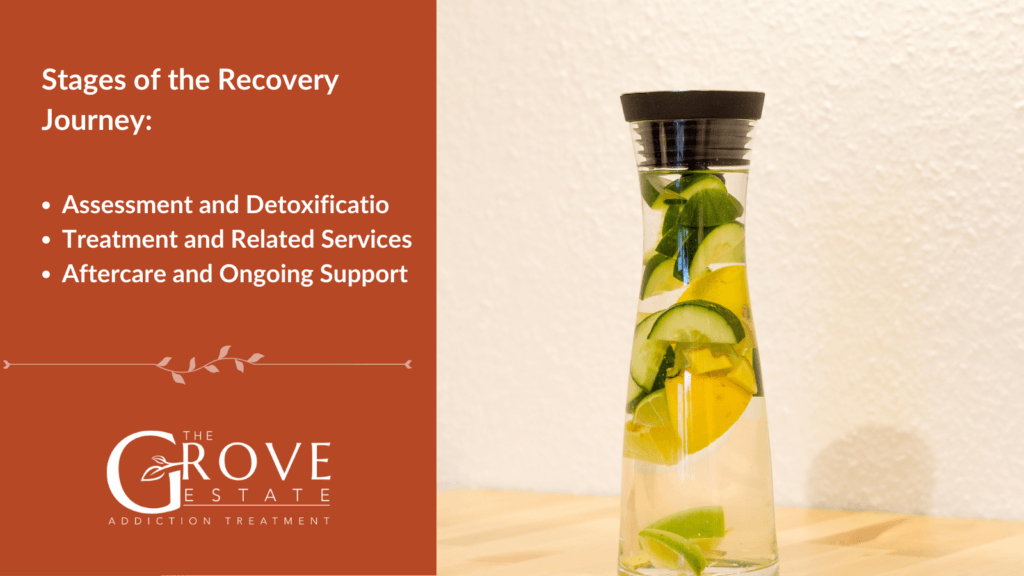Rehab is a structured program designed to help individuals struggling with addiction to overcome their dependence on substances, understand and work through the underlying issues that contribute to their addiction, and equip them with the tools for long-term recovery.
Rehab treatment is not a one-size-fits-all process and involves personalized programs catering to the individual’s mental, emotional, spiritual, and physical health to effectively address addiction. The rehab process includes both inpatient and outpatient treatments.
Effective rehab programs are multifaceted, encompassing individual and group counseling, family therapy, support services, and specialized therapies, and are followed by a crucial aftercare phase to support long-term recovery. About 70% of individuals in rehab for opioid addiction significantly reduced their level of use or fully abstained, according to the National Drug Monitoring Service.

The Principles of Rehab: A Personalized Approach
According to the National Institute on Drug Abuse (NIDA), over 106,000 people died from drug-related overdoses in 2021 in the United States. This fact is supported by the Centre for Disease Control and Prevention, who stated that unintentional poisoning, from drug Overdose, has become the leading cause of injury-realted deaths in the US. Hence, rehab is a very important intervention for addiction.
Rehab aids individuals by using a variety of interventions to help them in developing strategies to overcome their challenges, and supporting them to return to drug- and alcohol-free, productive, and healthy lives, according to the World Health Organisation (WHO).
Rehab does not subscribe to a one-size-fits-all approach. Effective substance abuse treatment programs recognize the unique needs and underlying causes of each individual’s addiction. Whether it’s mental, emotional, spiritual, or physical health, these factors are all considered when devising a personalized drug rehab program. As unique as our fingerprints, our addiction experiences call for an equally unique approach to healing through various drug rehab programs.
Such a personalized approach can involve a wide spectrum of therapy outlets, all tailored to cater to the individual’s unique addiction experiences and the specific health issues contributing to their addiction. Imagine a quilt, each patch representing a different facet of an individual’s life. The treatment plan, like a stitch, seamlessly connects these patches, resulting in a comprehensive approach to recovery.
What are the Types of Treatment Settings?
The setting holds significant value in the realm of rehab. Just like a plant needs the right environment to thrive, so does a person recovering from addiction. The two primary types of treatment settings are inpatient and outpatient care.
The choice between the two often depends on factors such as the severity of the addiction, the individual’s support system, and their ability to adhere to the treatment plan. But what do these settings entail?
Inpatient Treatment
Think of a residential treatment facility as a healing sanctuary with round-the-clock professional help and support. That’s what an inpatient rehab facility offers. It’s a structured environment where individuals with severe addictions or dual-diagnosis conditions can receive constant medical attention.
But it’s not just about medical care. Inpatient programs, akin to a well-orchestrated symphony, comprise diverse therapeutic sessions such as individual, group, and family sessions. This structure minimizes stress, provides a supportive environment, and most importantly, fosters healing. However, it’s worth noting that inpatient care may pose certain challenges such as the inability to work during treatment and potential issues with insurance coverage.
Outpatient Treatment
Outpatient treatment allows for diagnosis and treatment at a facility without the need for an extended stay or round-the-clock monitoring. However, with this flexibility, outpatient treatment may pose challenges such as a higher risk of accessing substances and comparably less medical support than inpatient settings. Intensive outpatient treatment can be a balancing act, and the scale tips depending on the individual’s unique circumstances.
Note: a combination of both inpatient and outpatient treatment can be used for an individual, if professionals think it is the best. So, they spend a brief period within a facility (inpatient) at the start of their addiction treatment and the rest of the treatment is outpatient.

What Are The Essential Components of an Effective Rehab Program?
An effective rehab program operates like a well-oiled machine with several interconnected components. These parts or components address the physical, mental, emotional, and social dimensions of recovery. The components include:
Individual and Group Counseling
Counseling plays a pivotal role in the rehab process, with the individual and group counseling sessions being guided by the patient’s treatment providers. The realm is divided into two territories: individual and group counseling, both of which are essential components of a comprehensive treatment plan designed by the patient’s or her treatment providers.
Individual counseling in rehab is a confidential sanctuary where individuals can:
- Explore their addiction-related experiences, symptoms, and thought patterns
- Embark on a journey of self-discovery
- Enhance self-awareness, communication skills, and coping mechanisms
Then there’s group therapy, a shared experience that fosters a sense of community and supports long-term recovery. Picture it like a round-table discussion, where each individual brings a unique perspective, contributing to a rich tapestry of shared experiences. The blend of individual and group counseling ensures that all angles of addiction are tackled.
Family Therapy
Family constitutes a significant ally in the battle against addiction. Family therapy in a rehab setting is about:
- addressing family dynamics
- improving relationships
- providing a robust support system for the individual in recovery.
Family therapy isn’t a one-size-fits-all approach. Some sessions may involve the entire family, while others may involve only a part of it, depending on each family’s unique needs and concerns. Various types of family therapies are employed, each targeting specific family dynamics and issues. Some common types of family therapy include:
- Structural family therapy
- Strategic family therapy
- Systemic family therapy
- Narrative therapy
- Solution-focused brief therapy
These different approaches allow therapists to tailor their interventions to the specific needs of each family.
Support Services
Rehab extends beyond treating addiction, it provides a safety net that caters to the multifaceted needs of recovering individuals beyond core treatment. These support services, often managed by mental health services administration, can include:
- Assistance with housing
- Employment support
- Legal assistance
- Medical care
Following the core treatment, the journey continues with aftercare, which includes outpatient services that support medication management and encourage participation in 12-step fellowship meetings. Think of it as a bridge, connecting the world of rehab with the real world, ensuring a smooth transition for individuals on their recovery journey.
Specialized Therapies and Approaches
Rehab programs utilize a range of specialized therapies and approaches to facilitate recovery. One such approach is art therapy, where painting, drawing, sculpting, and other creative outlets are used to express complex ideas and emotions non-verbally.
Another approach is cognitive-behavioral therapy (CBT), which addresses problematic thoughts and feelings, helping individuals identify links between their thoughts, emotions, and behaviors related to substance use disorders. Alongside these, drug abuse treatment options like holistic therapies such as acupuncture, meditation, and chiropractic care can be integrated into personalized treatment plans to support recovery from drug abuse symptoms.
What are the Stages of the Recovery Journey
1. Assessment and Detoxification
Detoxification, the process of expelling drugs or alcohol from the body, marks the first stage of the recovery journey. This stage is like the calm before the storm. It prepares the body for the therapeutic interventions that follow.
However, detoxification isn’t a straightforward process. It varies greatly depending on the type of drug used, the duration of addiction, the method of abuse, and individual factors such as family history and underlying medical conditions. It’s a delicate process, often involving medication management for withdrawal symptoms, ensuring a safer and more comfortable transition into the next stage of recovery.
2. Treatment and Related Services
The treatment stage commences after the detoxification process. This stage is like the heart of the recovery process, pumping life into the journey. Here, individuals undergo various therapies and interventions addressing not only the addiction but also co-occurring disorders like anxiety, bipolar disorder, and post-traumatic stress disorder (PTSD). The addiction treatment focuses on helping individuals overcome their substance abuse problems and achieve long-term recovery.
This stage is where the magic happens. It’s where broken pieces are put together, where healing begins. With a blend of individual and group counseling, family therapy, and support services, individuals are equipped with the right tools to combat addiction and reclaim control over their lives.
3. Aftercare and Ongoing Support
The recovery journey extends beyond the treatment stage. Like the epilogue of a book, aftercare and ongoing support provide a sense of closure and a roadmap for what lies ahead. Aftercare plans start during the treatment process and may include ongoing therapy, support group meetings, and relapse prevention strategies.
The role of aftercare in preventing relapse is crucial, particularly since the risk of relapse is highest in the first few months after leaving rehab. Having a strong aftercare plan is like having a safety net, ready to catch individuals if they stumble, reinforcing their commitment to the recovery journey.

How Do You Evaluate Rehab Success?
Evaluating rehab success involves more than just looking at abstinence rates. It encompasses improvements in overall physical and mental health, restored family connections, and advancements in schooling or employment. It’s a holistic evaluation, shedding light on the individual’s enhanced life outcomes.
What happens in case of a relapse? It’s important to remember that relapse doesn’t equate to treatment failure, with NIDA estimating that 40 to 60% individuals relapse while in recovery. Rather, it’s a signal for potential need for treatment re-evaluation and possibly a more intensive care approach. So, even in setbacks, there are opportunities for growth and learning.
Several factors influence how successful addiction rehab will be for different individuals. The factors include:
- The type of drug used, as well as frequency and duration
- Physical and mental health conditions
- Family and social environment, etc.
What does rehab deal with?
Rehab deals with the treatment of addiction to drugs and/or alcohol, involving a combination of medical treatment and psychotherapy. More than 20 million people were in need of substance abuse treatment in 2015, according to the National Survey on Drug Use and Health (NSDUH).
What are the goals of rehabilitation?
The main goals of rehabilitation are to maximize independence through therapeutic programming and enable participation in daily activities such as education, work, and recreation. These goals also include adapting to life with a disability, optimizing mobility, improving communication, and helping individuals care for themselves again.
What role does family therapy play in rehab?
Family therapy in rehab plays a crucial role in involving family members, addressing dynamics, improving relationships, and providing support for the individual in recovery. It can significantly impact the success of rehabilitation.
How do you identify an effective treatment facility?
The best rehab facilities use evidence-based therapies and have trained staff. So, research about the specifics of the therapies offered by a facility and the qualifications of its staff members before choosing a facility.
How does vocational rehabilitation integrate with addiction recovery?
Vocational rehabilitation is a crucial facet of the recovery journey for many individuals battling addiction. It provides them with the skills and training necessary to re-enter the workforce with confidence. This integration not only helps in building a routine but also boosts self-esteem, which is vital for long-term sobriety. According to Grand Canyon University, vocational rehabilitation programs are tailored to meet the specific needs of the individual, ensuring they have the best tools at their disposal to regain their professional standing.
In the broader scope of recovery, vocational rehabilitation acts as a bridge to normalcy and helps individuals in addiction recovery to forge a path to a productive and satisfying life. These programs are often linked with other therapeutic interventions within the rehab setting, thereby creating a comprehensive treatment approach that addresses both the psychological and practical aspects of recovery. By providing job training and employment assistance, these programs play a pivotal role in preventing relapse and promoting sustained recovery.
What is the importance of a residential detox in the initial stages of addiction treatment?
A residential detox is often the first step in the treatment of addiction, providing a safe and medically supervised environment for individuals to rid their bodies of toxins. This crucial phase is necessary for achieving physical stability and must be handled with utmost care to manage withdrawal symptoms effectively. Grand Canyon University highlights that a well-managed detox can significantly reduce the discomfort and risks associated with substance withdrawal, setting a solid foundation for the comprehensive treatment that follows.
Following the detox, patients usually transition to more intensive therapy forms, where they can explore the root causes of their addiction in a supportive environment. The detox process is not just about physical cleansing but also preparing the individual for the mental challenges ahead. It is essential for breaking the immediate physical dependence on substances and for starting the journey toward recovery with a clear mind and a healthier body.

Share This Post



